World Hearing Day, a campaign of the World Health Organization (WHO), recognizes the importance of hearing health care not only in the United States but around the world. This year, World Hearing Day is focused on hearing conservation through safe listening.
The ASHA Journals Program echoes this year’s World Hearing Day theme: “To hear for life, listen with care.” The articles we’re highlighting below focus on hearing loss prevention for people in at-risk professions and in at-risk or historically underserved populations.
Hearing Loss Prevention on the Job
Effectiveness of Hearing Loss Prevention Education for Active Duty Military Personnel: A Preliminary Study: Despite hearing loss prevention efforts in the military, hearing loss and tinnitus are still prevalent service-connected disabilities among veterans. In this article, the authors reviewed current hearing conservation understanding and practices in a group of active-duty military personnel.
Musicians’ Hearing Handicap Index: A New Questionnaire to Assess the Impact of Hearing Impairment in Musicians and Other Music Professionals: The authors developed and validated a new self-evaluation tool for people in the music industry who are at risk of music-induced hearing loss. The 29-item questionnaire successfully assessed occupational difficulties that musicians and sound engineers face due to hearing impairment.
Noise Exposure, Headsets, and Auditory and Nonauditory Symptoms in Call Center Operators: In this article, researchers found that more than 98% of the call center operators surveyed reported at least one auditory issue such as tinnitus, headache, or hearing impairment. The authors also found that call center operators preferred binaural headsets and that the use of these headsets resulted in lower sound pressure levels.
Hearing Loss Prevention in Underserved Populations
Noise Exposure and Use of Hearing Protection Among Adolescents in Rural Areas: Children in rural areas are more likely to be exposed to noise damage via gunfire, heavy machinery, power tools, and all-terrain vehicles (ATVs). In this article, the authors found that rural adolescents rarely wear hearing protection, despite being informed of the effects of these noises on their hearing.
Online, Asynchronous Hearing Education and Research Project for Ethnically Diverse Adolescents via Interprofessional Collaboration and Electronic Service-Learning During the COVID-19 Pandemic: A Pilot Study on the Needs and Challenges: This article discusses the creation and testing of an online presentation to educate students about noise-induced hearing loss, delivered online during the COVID-19 pandemic. The authors point out that educating children young is particularly important, as more students were listening through devices during the pandemic.
Opioid-Induced Hearing Loss and Neonatal Abstinence Syndrome: Clinical Considerations for Audiologists and Recommendations for Future Research: There is considerable overlap between populations at-risk for hearing loss and opioid misuse. This article looks at current evidence about the links between opioid abuse and hearing loss, as well as treatment standards for those with opioid-related hearing loss or neonatal abstinence syndrome.
“To Hear for Life, Listen With Care”
You can learn more about World Hearing Day on the campaign’s official website. For those of you on social media, you can also check out—and use!—the hashtags #safelistening, #worldhearingday, and #hearingcare.
For more information, read our previous coverage of World Hearing Day or learn more about hearing health at home. We hope that these resources can help you advocate for hearing conservation and noise protection both in your communities and beyond!









